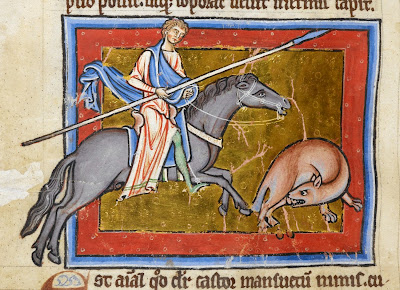1 Lecture
Summary:
How to contain a thousand years of art in one hour?
* Video - a unique LizPresents video (ca 18 mins + voice over) with a broad selection of manuscript illuminations and styles with explanations of context and content.
* Slideshow - an overview of the manuscript era in Europe: manuscript creation from sheep to scribe to illuminator; art in the margins; and a closer look at some exceptional manuscripts.
VIDEO - DRAGONS! The Rutland Psalter 1260
*******
The Medieval Manuscript is in a format known as a codex, put simply a fully handmade, hand written and illustrated book with covers and pages to turn whose origins date back to 2-400 AD. They were replaced by printed books beginning in 1450 and their wild originality faded away over the next 150 years, although they continued, and continue, to be made as works of art.
The codex or book format's success was due to its convenience, portability, and easily displayed pages. It became the norm when large volumes of text needed to be recorded. [Scrolls or sheets continued to be the major format for bureaucratic and legal records.]
Into the codex was written - copied from other documents or from ancient scrolls - the knowledge and beliefs of the world. And it was these documents that helped bring literacy into the dark corners of the western world. One wonders: if the codex had not been so portable, so easy to display, so magically illuminated and enticing - and the early christians not so intent on spreading the word - then how much longer would the spread of literacy have taken?
Whether religious in content or not, the illuminations range from beautiful (as in the image at the top of this post) to extraordinary rampant displays of dragons, strange disfigured people, animals and hell. All reflect the insecurity of medieval peoples who felt their world was constantly threatened by the devil, disorder and apocalypse.
But life itself DOES go on, and that's shown by wonderful 'cartoons' of the routines of life - work, entertainment and sex - a reminder that people lived, loved and behaved badly then just as now.
And it is in manuscripts that great art existed for centuries before it burst forth onto canvasses and walls. Many artist of the early Rennaissance period (such as Van Eyck) were manuscript illustrators as well as artists...one explanation for their often extraordinary ability to describe detail.
The illuminations are frequently hard to comprehend - even scholars are unsure of their exact symbolism - why grotesque creature or mockeries of human behaviour right next to Christ? Clearly 'we' cannot conceive of the medieval mind but we can see that the images are often sharp commentaries on the absurdity or immorality of man and always making the point that evil is ever present. Conjecture or guesswork about their meaning is what makes them so fascinating - and fun. In the early intensively decorated manuscripts (such as Kells) the often incomprehensible illuminations and carpet pages were often MEANT to be so, reflecting on the mystery of God, in fact encouraging reflection...and that is true of texts from all beliefs. Even the creation of the illuminations was considered a form of reverence.
High quality digitised copies on line are available from nearly all major libraries and museums.
For those who want to get a first hand look at MSS in the British Library, a list of documents shown at the lecture is available. To learn how to access and view them - open link below for a mini tutorial
Link to How to Access Brit Lib Documents
















